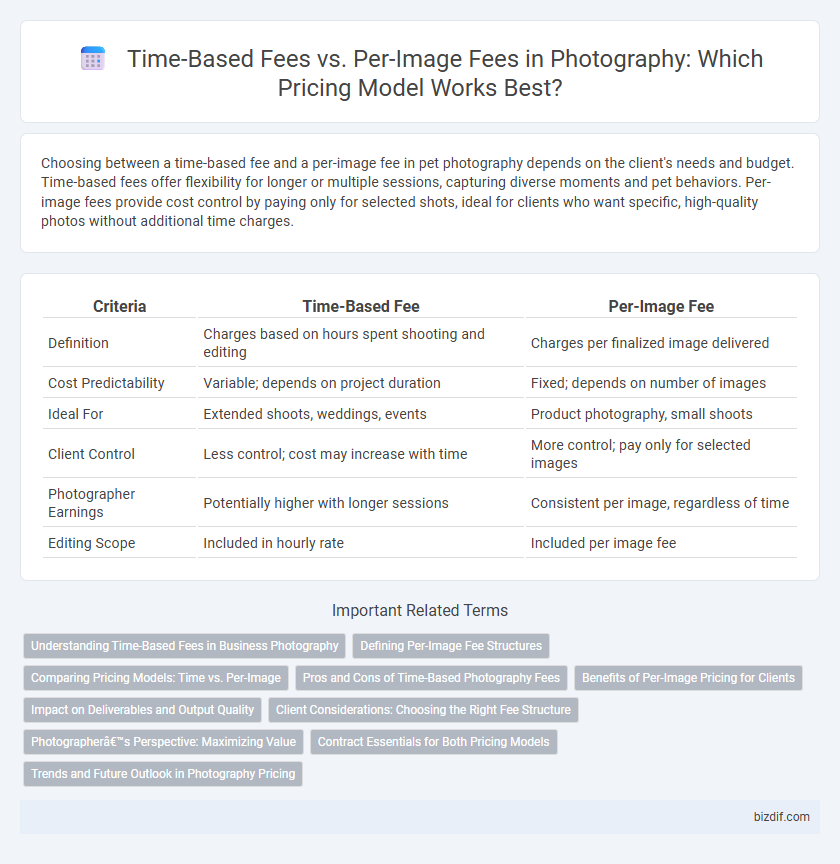Choosing between a time-based fee and a per-image fee in pet photography depends on the client's needs and budget. Time-based fees offer flexibility for longer or multiple sessions, capturing diverse moments and pet behaviors. Per-image fees provide cost control by paying only for selected shots, ideal for clients who want specific, high-quality photos without additional time charges.
Table of Comparison
| Criteria | Time-Based Fee | Per-Image Fee |
|---|---|---|
| Definition | Charges based on hours spent shooting and editing | Charges per finalized image delivered |
| Cost Predictability | Variable; depends on project duration | Fixed; depends on number of images |
| Ideal For | Extended shoots, weddings, events | Product photography, small shoots |
| Client Control | Less control; cost may increase with time | More control; pay only for selected images |
| Photographer Earnings | Potentially higher with longer sessions | Consistent per image, regardless of time |
| Editing Scope | Included in hourly rate | Included per image fee |
Understanding Time-Based Fees in Business Photography
Time-based fees in business photography charge clients according to the hours spent on shooting, editing, and consultations, providing flexibility for complex projects. This model often suits corporate events, product shoots, and marketing campaigns where time investment varies significantly. Understanding the value of time-based fees helps photographers balance workload with fair compensation, ensuring detailed attention and customized service.
Defining Per-Image Fee Structures
Per-image fee structures charge clients based on the number of finalized photographs delivered, providing transparent and predictable costs for both photographers and clients. This pricing model aligns compensation directly with the creative output, encouraging efficiency and clear budgeting. Time-based fees charge for hours worked but may introduce variability, whereas per-image fees facilitate straightforward valuation of individual images in professional photography projects.
Comparing Pricing Models: Time vs. Per-Image
Time-based fees in photography offer predictability by charging clients for the duration of the shoot, ideal for diverse sessions with variable output. Per-image fees provide transparent pricing tied directly to deliverables, making it easier for clients to budget based on the number of final images. Comparing pricing models highlights that time-based fees benefit projects with extensive coverage needs, while per-image fees suit clients prioritizing specific image quantities and quality.
Pros and Cons of Time-Based Photography Fees
Time-based photography fees offer flexibility by charging clients for the actual duration of the shoot, which can accommodate varying project scopes and unexpected changes. This pricing model ensures photographers are compensated for overtime and extensive editing, avoiding undervaluation common with flat per-image fees. However, it may lead to client uncertainty about final costs and requires precise time tracking to maintain transparency and trust.
Benefits of Per-Image Pricing for Clients
Per-image pricing offers clients clear transparency and budget control by specifying costs upfront for each photograph, preventing unexpected expenses that often arise with time-based fees. This pricing model encourages photographers to deliver high-quality, meticulously crafted images, as payment directly correlates with the final product rather than the duration of the shoot. Clients benefit from flexibility and fairness, only paying for the visuals they value, resulting in a tailored and cost-effective photography experience.
Impact on Deliverables and Output Quality
Time-based fees in photography allow for flexible work hours, encouraging photographers to invest more effort into perfecting shots and post-processing, resulting in higher-quality deliverables. Per-image fees create a direct correlation between the number of images delivered and payment, sometimes leading to rushed shoots and less attention to detail to maximize output. Selecting the right fee structure significantly influences the balance between quantity and quality of the final photographic product.
Client Considerations: Choosing the Right Fee Structure
Clients should evaluate the scope and complexity of their photography project when choosing between time-based fees and per-image fees. Time-based fees provide flexibility for sessions with unpredictable durations or extensive editing, while per-image fees offer clarity and control for projects with a fixed number of deliverables. Understanding project goals, budget constraints, and desired outcomes helps clients select a fee structure that aligns with their specific needs and ensures transparent pricing.
Photographer’s Perspective: Maximizing Value
Photographers can maximize revenue by choosing time-based fees when offering extensive shoots, allowing compensation for hours invested regardless of image count. Per-image fees enable precise pricing for clients seeking specific outputs, optimizing earnings on high-demand, quality selections. Evaluating project scope and client goals ensures strategic fee structures align with both creative workload and market standards.
Contract Essentials for Both Pricing Models
Time-based fee contracts require clear definitions of hourly or daily rates, specifying the total hours expected and any overtime charges. Per-image fee agreements must outline the exact number of deliverable photos, usage rights, and conditions for additional image purchases. Both pricing models benefit from explicit terms on payment schedules, cancellation policies, and intellectual property ownership to avoid disputes.
Trends and Future Outlook in Photography Pricing
Time-based fees in photography remain popular for dynamic projects requiring flexibility, with increasing adoption of hybrid models combining hourly rates and per-image fees to optimize revenue. Emerging trends indicate a shift towards subscription-based pricing and value-based packages that emphasize usage rights and client needs over traditional per-image charges. Future outlook suggests photographers leveraging AI tools for efficient editing, enabling competitive fixed fees while maintaining profitability in a market driven by digital content demand.
Time-based fee vs Per-image fee Infographic

 bizdif.com
bizdif.com